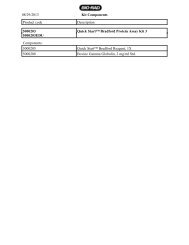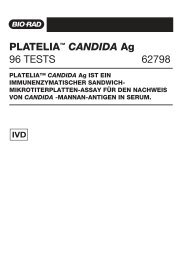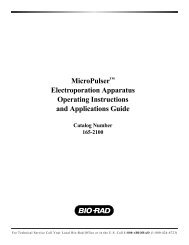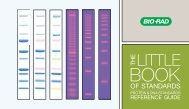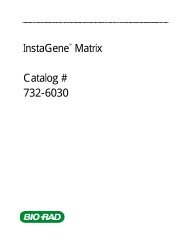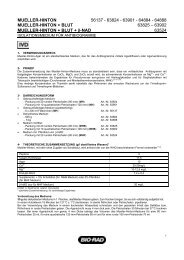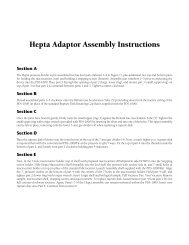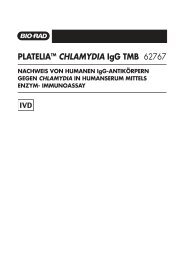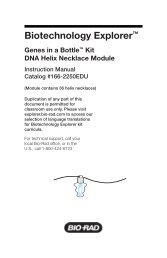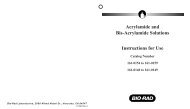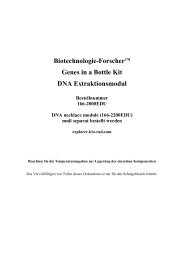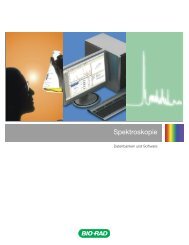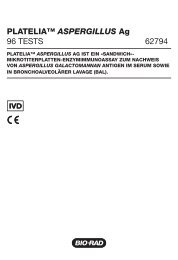Protein Expression and Purification Series - Bio-Rad
Protein Expression and Purification Series - Bio-Rad
Protein Expression and Purification Series - Bio-Rad
Create successful ePaper yourself
Turn your PDF publications into a flip-book with our unique Google optimized e-Paper software.
<strong>Protein</strong> <strong>Expression</strong> <strong>and</strong> <strong>Purification</strong> <strong>Series</strong><br />
250<br />
150<br />
100<br />
75<br />
50<br />
37<br />
25<br />
20<br />
15<br />
10<br />
Figure 8.30. Example of fractions selected from the chromatogram <strong>and</strong> the corresponding SDS-PAGE results.<br />
Lane 1. Precision Plus Dual Color St<strong>and</strong>ards.<br />
Lane 2. Soluble fraction of E. coli cell lysate. A b<strong>and</strong> is present that is the GST-DHFR-His which is soluble. The large b<strong>and</strong> at approximately<br />
12 kDa is the lysozyme, which is also soluble, that was used to lyse the cells open.<br />
Lane 3. Flowthrough fraction which did not bind to the Ni-IMAC resin. This is the fraction of proteins from the soluble fraction<br />
that did not bind to the Ni-IMAC resin. The soluble fraction was suspended in 20 mM sodium phosphate buffer, 300 mM NaCl <strong>and</strong> 5<br />
mM imidazole. The high salt helped prevent E. coli proteins <strong>and</strong> the lysozyme from non-specifically sticking to the Ni-IMAC beads.<br />
The 5 mM imidazole helped prevent E. coli proteins with multiple histidine groups from binding to the Ni-IMAC beads. There is a<br />
decrease in the amount of GST-DHFR-His in the flowthrough fraction versus the soluble fraction (lane 2) <strong>and</strong> this is representative of<br />
the GST-DHFR-His binding to the Ni-IMAC resin.<br />
Lane 4. Wash fraction. This fraction contains proteins that were washed off the Ni-IMAC beads when a wash buffer that has a<br />
slightly higher imidazole level (10 mM) was added to wash off more non-specifically bound proteins. No GST-DHFR-His should wash<br />
off in this fraction since 10 mM imidazole is not enough to compete with the 6 histidine tag of GST-DHFR-His bound to the Ni-IMAC<br />
resin.<br />
Lanes 5, 7,<strong>and</strong> 9. Eluate fraction of GST-DHFR-His. These fractions contain the GST-DHFR-His. The elution buffer has 250 mM<br />
imidazole in it <strong>and</strong> this level of imidazole competes with the six histines of GST-DHFR-His <strong>and</strong> knocks them off the Ni sites <strong>and</strong><br />
hence the GST-DHFR-His elutes or comes off the resin to be collected. These fractions are predominantly GST-DHFR-His protein<br />
relative to the unpurified soluble fraction in lane 2 that contains many other proteins.<br />
Lane 6, 8, <strong>and</strong> 10. Desalted GST-DHFR-His. These fractions contain the purified GST-DHFR-His but have had the 250 mM imidazole<br />
removed. Also, since the desalting column removes smaller molecular weight compounds, some of the smaller molecular<br />
weight impurities found in lanes 5,7 <strong>and</strong> 9 are not present in the desalted fractions.<br />
Chapter 8: <strong>Purification</strong> Protocol for <strong>Bio</strong>Logic DuoFlow System<br />
1 2 3 4 5 6 7 8 9 10<br />
Flowthrough Wash<br />
195<br />
Elute<br />
Column wash<br />
CHAPTER 8<br />
BIOLOGIC DUOFLOW<br />
PROTOCOL



